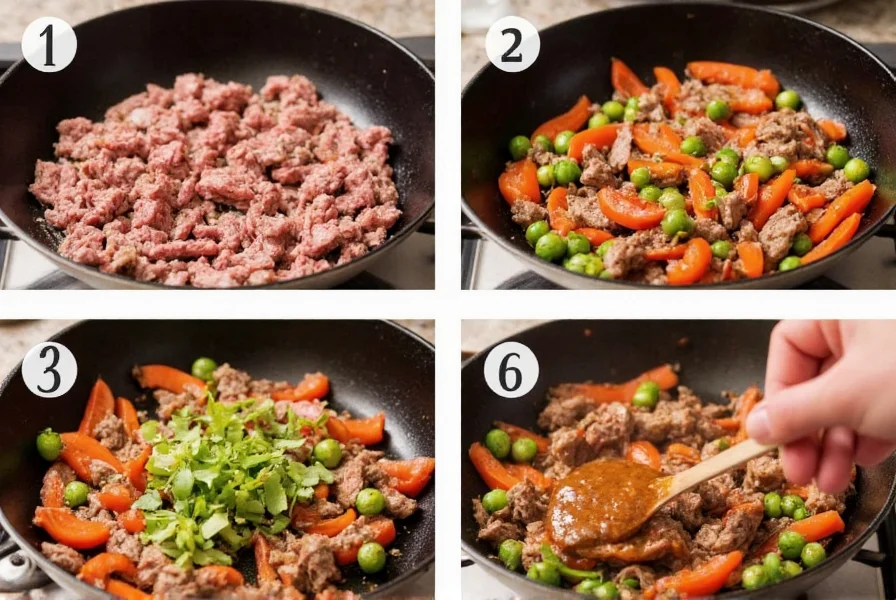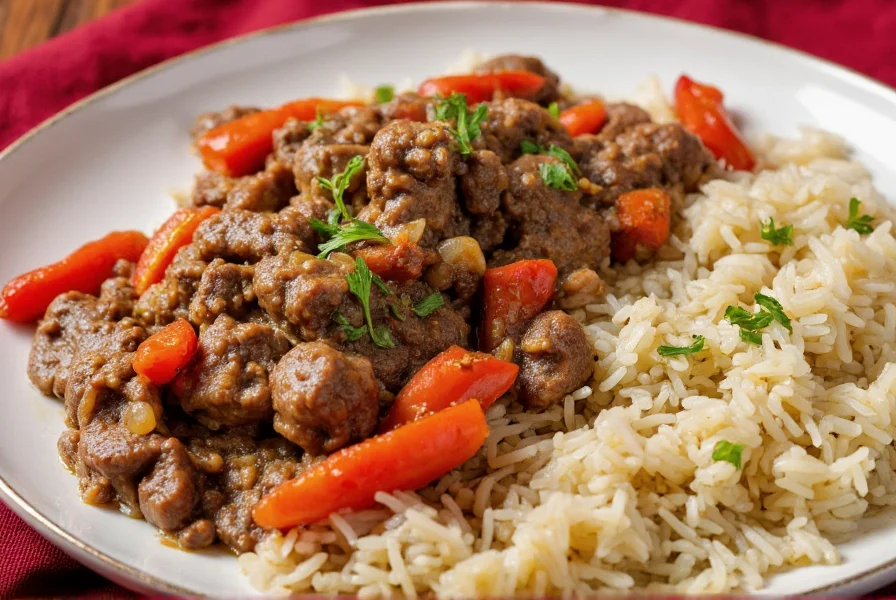If you've ever wondered how to recreate that restaurant-quality pepper steak and rice at home, you're in the right place. This beloved American-Chinese comfort food combines tender beef, crisp vegetables, and a rich umami-packed sauce that soaks beautifully into fluffy white rice. Unlike many takeout versions, our approach focuses on maximizing flavor while keeping the cooking process straightforward for home chefs.

The Essential Components of Authentic Pepper Steak
Creating exceptional pepper steak and rice starts with understanding its foundational elements. The magic happens through three critical components working in harmony: the beef preparation, the vegetable balance, and the sauce formulation.
For the beef selection, flank steak remains the traditional choice due to its rich flavor and ability to absorb marinades. However, sirloin or skirt steak work equally well if sliced properly against the grain. The key to tender pepper steak lies in the velveting technique—a Chinese cooking method where meat marinates in cornstarch, egg white, and rice wine before quick frying. This creates a protective layer that seals in juices during the high-heat stir-fry.
When selecting vegetables, aim for color contrast and texture variety. Traditional recipes use equal parts green and red bell peppers with white onion, but adding mushrooms or baby corn enhances complexity. Cut all vegetables uniformly to ensure even cooking—nobody wants mushy peppers alongside crunchy onions.
Step-by-Step Recipe for Perfect Pepper Steak and Rice
This streamlined pepper steak and rice recipe delivers restaurant-quality results without special equipment. Follow these steps for consistently delicious outcomes:
| Prep Time | Cook Time | Total Time | Servings |
|---|---|---|---|
| 20 minutes | 10 minutes | 30 minutes | 4 |
Ingredients
- 1.5 lbs flank steak, thinly sliced against the grain
- 3 bell peppers (mixed colors), sliced into strips
- 1 large white onion, sliced
- 3 cloves garlic, minced
- 1 tbsp fresh ginger, grated
- 2 cups cooked jasmine rice
Sauce Components
- 3 tbsp soy sauce
- 2 tbsp oyster sauce
- 1 tbsp rice vinegar
- 1 tbsp brown sugar
- 1 tsp sesame oil
- 1/4 cup beef broth
- 1 tbsp cornstarch
Marinade for Beef
- 1 tbsp soy sauce
- 1 tbsp rice wine or dry sherry
- 1 tsp cornstarch
- 1 egg white
Preparation Method
- Marinate the beef: Combine steak with marinade ingredients and refrigerate for 15-20 minutes. This velveting process ensures tender results.
- Prepare sauce: Whisk all sauce ingredients in a bowl until cornstarch dissolves completely.
- Cook rice: Prepare jasmine rice according to package directions while preparing other components.
- Stir-fry technique: Heat 2 tbsp oil in wok or large skillet over high heat. Cook beef in single layer for 1-2 minutes until browned but not fully cooked. Remove and set aside.
- Vegetable stage: Add remaining oil to wok, stir-fry peppers and onions for 2-3 minutes until crisp-tender.
- Combine elements: Return beef to wok, pour sauce over ingredients, and cook until sauce thickens and coats everything evenly (about 1 minute).
- Final touch: Remove from heat, stir in half the green onions, and serve immediately over rice.

Proven Techniques for Restaurant-Quality Results
Mastering pepper steak and rice requires understanding several professional techniques that transform good dishes into exceptional ones. The high-heat stir-fry method remains non-negotiable—your pan must be smoking hot before adding ingredients. This sears the beef instantly, preventing steaming and ensuring proper caramelization.
Another critical factor is sauce consistency. Many home cooks struggle with either watery or gloppy sauces. The solution lies in the cornstarch slurry ratio and proper cooking temperature. Always mix cornstarch with cold liquid before adding to hot ingredients, and never let the sauce boil vigorously after thickening, as this breaks down the starch molecules.
For those seeking gluten-free pepper steak and rice, substitute tamari for soy sauce and ensure your oyster sauce is gluten-free (or use mushroom sauce as alternative). The dish maintains its signature flavor profile while accommodating dietary restrictions.
Regional Variations and Creative Twists
While the classic American-Chinese version dominates takeout menus, regional adaptations offer exciting alternatives. In authentic Chinese cuisine, you'll find Hunan-style pepper steak featuring dried chilies and Sichuan peppercorns for numbing heat. Some California restaurants incorporate fresh pineapple for subtle sweetness, while Texan versions might include jalapeños for extra kick.
For healthy pepper steak and rice modifications, consider these adjustments:
- Use cauliflower rice instead of white rice for lower carbs
- Substitute lean sirloin for flank steak to reduce fat content
- Add broccoli florets for increased vegetable content
- Reduce sugar in sauce by half and increase rice vinegar
Meal preppers will appreciate that pepper steak and rice reheats exceptionally well. Store components separately—sauce tends to absorb into rice over time. When reheating, add a splash of water to revive the sauce consistency.
Avoiding Common Pepper Steak Mistakes
Even experienced cooks encounter pitfalls when preparing pepper steak and rice. The most frequent error involves overcrowding the pan. Adding too much beef at once drops the pan temperature dramatically, causing the meat to steam rather than sear. Cook in batches if necessary, maintaining that crucial high heat.
Another widespread issue is improperly sliced vegetables. Uneven cuts lead to inconsistent cooking—some pieces become mushy while others remain crunchy. Aim for uniform 1/4-inch thick slices across all vegetables. When working with bell peppers, remove the white pith for better texture and appearance.
Don't underestimate the importance of rice quality either. Undercooked or overcooked rice detracts from the entire dish. For perfect steamed rice, use a 1:1.5 rice-to-water ratio and let it rest covered for 10 minutes after cooking before fluffing.
Serving Suggestions and Pairings
Pepper steak and rice stands beautifully on its own as a complete meal, but strategic accompaniments elevate the experience. A simple cucumber salad with rice vinegar provides refreshing contrast to the rich main course. For special occasions, pair with egg drop soup to create a full Chinese dining experience.
When plating, use the rice foundation technique—mound rice slightly off-center on the plate, then spoon pepper steak mixture over and around it. This presentation showcases both components while allowing the vibrant sauce to cascade attractively. Garnish with remaining green onions and sesame seeds for professional finishing touches.
Frequently Asked Questions
What's the best cut of meat for pepper steak?
Flank steak remains the traditional choice for pepper steak due to its rich beefy flavor and ability to absorb marinades. For optimal tenderness, always slice against the grain into thin strips. Sirloin or skirt steak work well as alternatives, but avoid tougher cuts like chuck that won't tenderize properly during quick stir-frying.
How do I prevent my pepper steak from becoming tough?
The key to tender pepper steak involves three critical steps: proper slicing against the grain, velveting with cornstarch and egg white marinade, and quick high-heat cooking. Never overcook the beef—remove it from the pan when still slightly underdone, as it will continue cooking from residual heat. Marinating for 15-20 minutes (not hours) prevents the meat from becoming mushy.
Can I make pepper steak and rice ahead of time?
Yes, but store components separately for best results. Cook the rice and keep it covered at room temperature for up to 4 hours, or refrigerate for longer storage. Prepare the pepper steak mixture and sauce separately, then combine only when ready to serve. Reheat in a hot skillet with a splash of water to restore sauce consistency. Avoid combining rice and pepper steak until serving to prevent sogginess.
What gives pepper steak its characteristic glossy sauce?
The glossy finish comes from proper starch thickening. When cornstarch in the sauce mixture reaches 203°F (95°C), it undergoes gelatinization, creating that signature shine. The key is maintaining high heat while stirring constantly as the sauce thickens. Using a combination of soy sauce, oyster sauce, and sesame oil contributes to both the sheen and rich flavor profile that defines authentic pepper steak.











 浙公网安备
33010002000092号
浙公网安备
33010002000092号 浙B2-20120091-4
浙B2-20120091-4